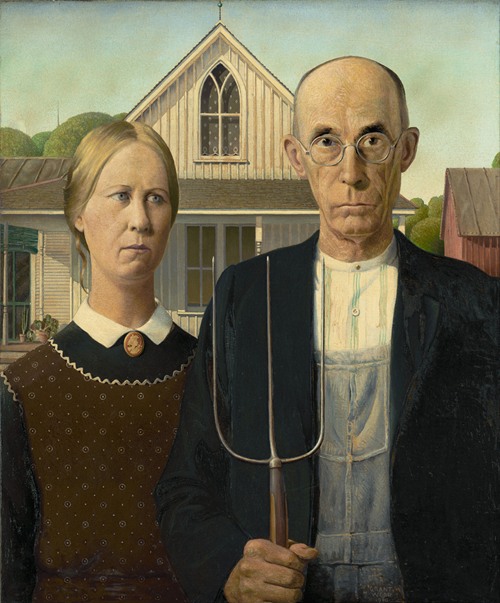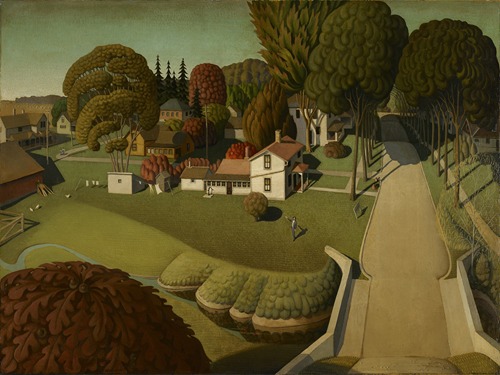

Grant DeVolson Wood was an American painter and representative of Regionalism, best known for his paintings depicting the rural American Midwest. He is particularly well known for American Gothic (1930), which has become an iconic example of early 20th-century American art.
Wood was born in rural Iowa, 4 mi (6.43 km) east of Anamosa, on February 13, 1891, the son of Hattie DeEtte Weaver Wood and Francis Maryville Wood. His mother moved the family to Cedar Rapids after his father died in 1901. Soon thereafter, Wood began as an apprentice in a local metal shop. After graduating from Washington High School, Wood enrolled in The Handicraft Guild, an art school run entirely by women in Minneapolis in 1910.
In 1913, he enrolled at the School of the Art Institute of Chicago and performed some work as a silversmith.
Close to the end of World War I, Wood joined the US military, working as an artist designing camouflage scenes as well as other art.
From 1919 to 1925, Wood taught art to junior high school students in the Cedar Rapids public school system. This employment provided financial stability and its seasonal nature allowed him summer trips to Europe to study art. In addition, he took a leave of absence for the 1923–1924 school year so he could spend an entire year studying in Europe.
From 1922 to 1935, Wood lived with his mother in the loft of a carriage house in Cedar Rapids, which he turned into his personal studio at "5 Turner Alley" (the studio had no address until Wood made one up).
From 1922 to 1928, Wood made four trips to Europe, where he studied many styles of painting, especially Impressionism and post-Impressionism. However, it was the work of the 15th-century Flemish artist Jan van Eyck that influenced him to take on the clarity of this technique and to incorporate it in his new works. In addition, his 1928 trip to Munich was to oversee the making of the stained glass windows he had designed for a Veterans Memorial Building in Cedar Rapids.
In 1932, Wood helped found the Stone City Art Colony near his hometown to help artists get through the Great Depression. He became a great proponent of regionalism in the arts, lecturing throughout the country on the topic. As his classically American image was solidified, his bohemian days in Paris were expunged from his public persona.
From 1934 to 1941 Wood taught painting at the University of Iowa's School of Art. During that time, he supervised mural painting projects, mentored students, produced a variety of his own works, and became a key part of the university's cultural community.
From 1935 to 1938, Wood was married to Sara Sherman Maxon. Friends considered the marriage a mistake for Wood.
Wood was a closeted homosexual. There was an unsuccessful attempt by a colleague, Lester Longman, to get him fired both on explicit moral grounds and for his advocacy of regionalism. Critic Janet Maslin states that his friends knew him to be "homosexual and a bit facetious in his masquerade as an overall-clad farm boy." University administration dismissed the allegations and Wood would have returned as professor if not for his growing health problems.
Wood was an avid Freemason and Member of Mount Hermon Lodge #263 in Cedar Rapids, Iowa. After receiving his 3rd Degree of Master Mason he painted The First Three Degrees of Freemasonry in 1921.
On the eve of his 51st birthday, Wood died at Iowa City university hospital of pancreatic cancer. He is buried at Riverside Cemetery, Anamosa, Iowa.
When Wood died, his estate went to his sister, Nan Wood Graham, the woman portrayed in American Gothic. When she died in 1990, her estate, along with Wood's personal effects and various works of art, became the property of the Figge Art Museum in Davenport, Iowa.
The World War II Liberty Ship SS Grant Wood was named in his honor.
In 2009, Grant was awarded the Iowa Prize, the state's highest citizen honor.
Grant Wood Area Education Agency, one of Iowa's nine regional Area Education Agencies established in 1974, which serves Eastern Iowa, was named after Wood.


